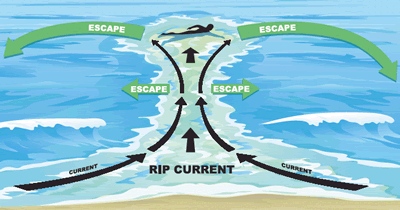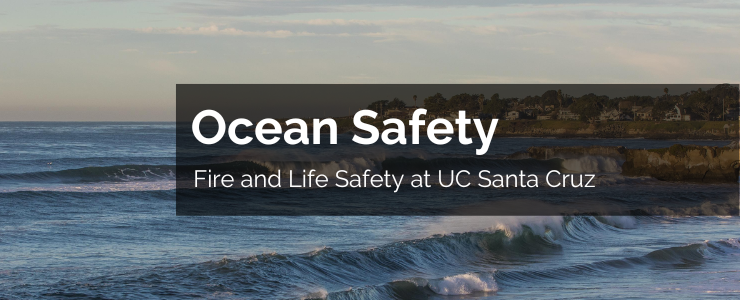Ocean Safety
Among the many benefits that come with the UC Santa Cruz location is our proximity to local beaches. In fact, metro routes can take you straight from the redwoods to the shore! However, there are risks and hazards associated with beach adventures and some specific to the Santa Cruz coastline. This page will provide context, resources, and guidance for your safety.
Beach Safety - Read the Flags
When you visit the beach, oftentimes there will be a flag denoting current conditions for your awareness. Understanding what the flags indicate is an important step to set your expectations for what the conditions are like in the water. However, regardless of the flags, you should understand that water conditions can change quickly.
If you are planning to go surfing, you should also check the more detailed Surf Report and Forecast. This resource provides excellent and comprehensive information for novice and professional surfers alike.
| Beach Safety Flag | Color | Meaning |
 |
Yellow | Medium Hazard |
 |
Red | High Hazard |
 |
Red over Red | Water Closed to Public Use |
 |
Purple | Marine Pests Present (potentially includes jellyfish, sharks, etc) |
 |
Red over Yellow | Recommended Swimming Area with Lifeguard Supervision |
 |
Black and White (Quartered) | Watercraft Only Area |
 |
Yellow flag with Black | Watercraft Use Prohibited (Including no Surfboards) |
 |
Orange Windsock | Offshore Winds Present, No Inflatables |
 |
Red and White (Quartered) | Emergency Evacuation |
Water Conditions
Whether you are new to the coast or a veteran beachgoer, there are several important safety conditions to be mindful of when going out to the sea!

- Rip Currents - These are powerful, channeled currents of water flowing away from shore. They typically extend from the shoreline, through the surf zone, and past the line of breaking waves. Rip currents can occur at any beach with breaking waves or where there is a stream or outflow into the surfline. The majority of ocean rescues made by lifeguards are due to victims struggling in rip currents.
- "Rogue" or "Sleeper" Waves - These are common names given to a wave that is larger than the average wave height that has been observed. These can be unpredictable waves, which may occur even on days when most of the surf looks small and unspectacular. These large waves have been the cause of too many drownings over the years and can catch those close to the shoreline by surprise, washing them into the cold, turbulent water. Most victims were climbing on rocks and cliffs, playing near or in the surf, or shore fishing.
Be Safe - What to Do
- Never swim alone.
- Be cautious at all times, especially when swimming at unguarded beaches. If in doubt, don’t go out!
- Whenever possible, swim at a lifeguard-protected beach.
- Obey all instructions and orders from lifeguards.
- If caught in a rip current, remain calm to conserve energy and think clearly.
- Don’t fight the current. Swim out of the current in a direction following the shoreline. When out of the current, swim towards shore.
- If you are unable to swim out of the rip current, float or calmly tread water. When out of the current, swim towards shore.
- If you are still unable to reach shore, draw attention to yourself: face the shore, wave your arms, and yell for help.
- If you see someone in trouble, get help from a lifeguard. If a lifeguard is not available, have someone call 9-1-1. Throw the rip current victim something that floats and yell instructions on how to escape.
Santa Cruz Safety
| Don't Be Next | Know Before You Go |
|
Don't Be Next (2022) - UCSCZ from Cal Fire Prevention Organization on Vimeo. |
Know Before You Go - Wildlife (UCSCZ) from Cal Fire Prevention Organization on Vimeo. |
|
Know Before You Go (Cliffs) - UC Santa Cruz from Cal Fire Prevention Organization on Vimeo.
|
|
The Toilet Bowl is a notorious and deadly cove in Santa Cruz that is well known for both swimmer deaths and close-calls due to a litany of hazardous water conditions. The video below explains the area and the risks in detail. In short, do not put yourself and your would-be rescuers at risk.
A Deadly Swim: Santa Cruz's Notorious Toilet Bowl from mysafela.org on Vimeo.
Additional Resources
If you would like to learn more about beach safety from experts and public safety organizations, please see our linked resources below.
- Ocean Safety - California State Parks
- Safety Tips - California Surf Lifesaving Association
- Marine Safety Division - City of Santa Cruz Fire Department

